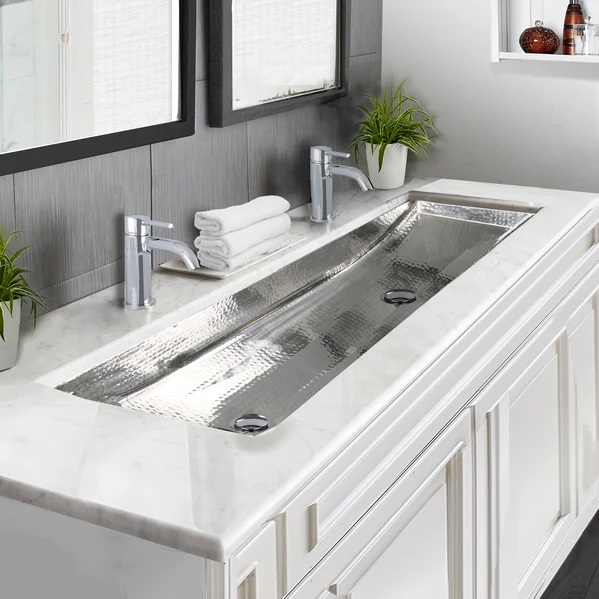That stainless steel bathrooms are elegant is not in question. We see them in establishments and homes of all kinds, a testament to their wide acceptance. But there’s another side to this material, one that’s equally remarkable.
If you value environmental preservation, you’ll be pleased to know that, beyond its beauty and elegance, stainless steel is a notable driver of ecofriendliness. Below, we’ll discuss how stainless steel promotes sustainability and how buying stainless steel bathroom sinks contributes to sustainable living.
How Stainless Steel Bathroom Sinks Promote A Sustainable Lifestyle
So, what green reasons do you have to opt for stainless steel bathroom sinks? Quite a number, as it turns out. Here are the different ways choosing stainless steel over other materials for your bathroom sinks boosts sustainability.

They Are 100% Recyclable
No other metal matches stainless steel recyclability. The material is 100% recyclable, making it the most recyclable metal in the world. At least 85% of all stainless steel used in the home and architecture market, where bathroom sinks fall, is recyclable. Unrecyclable stainless steel bits can be used as raw materials for making other products, so nothing goes to waste.
Goes to show that anyone keen on embracing a sustainable lifestyle should make stainless steel one of their materials of choice for many products. At the home front, we have various stainless steel sinks, options anyone can use to make this goal a reality. You can start at the bathroom—with sinks, vanity sinks, and faucets.
Miners Source Stainless Steel Raw Materials Responsibly
To create stainless steel, manufacturers use a combination of:
- Iron
- Carbon
- At least 10% chromium
- Nickel
- And several other elements.
All stainless steel components are mined responsibly and do not require excessive resources. For example, iron is the fourth most abundant element on the Earth’s crust, while nickel is the fifth. There is little risk of exhausting the two, but that does not mean all caution goes to the wind while sourcing these minerals.
Manufacturers use the same caution and care when sourcing less abundant components, such as chromium and carbon. Indeed, stainless steel manufacturers are bound by the sourcing and best practice guidelines set by regulatory bodies such as the International Chrome Development Institute.
The Mining Policy Framework by the Intergovernmental Forum on Mining (IGF) also outlines a comprehensive path towards sustainable development through efficient mining. Stainless sink manufacturers operating in IGF member states must follow the mining regulatory framework laid down to work towards IGF’s sustainable development objectives.
Mining Stainless Steel Compounds Does Not Produce Toxic Run-Off
None of the elements used to make stainless steel produce toxic mine drainage. Runoff from stainless steel production:
- Is not toxic
- Does not react with other elements to form dangerous compounds
- Does not dissolve toxic elements, causing them to seep into groundwater
- Does not harm plant or animal life
- Does not corrode items it comes into contact with.
Additionally, all stainless steel constituent metals have low toxicity and are not known to harm the environment.
They Do Not Require Surface Coating
Bathroom sinks and faucets made out of stainless steel do not require any surface coating. The steel is simply given a finish, usually satin, mirror luster, or brushing. But no product is added to create that final metallic look.
The problem with coatings is that they deteriorate over time. As they break down, they mix with the water running through the sink, polluting it. Some compounds in the coating may be toxic, causing harm to organisms that come in contact with the water. Using stainless steel sinks eliminates this risk.
They Are Durable
Many experts agree that stainless steel is among the most durable materials. The average stainless steel sink lasts between 15 and 30 years, a lifetime by industry standards. You can ward off rust and increase the lifespan by taking good care of the sink.
This longer lifespan means you’ll not replace the sink for a long time. Instead, you’ll have decades of worry-free use to enjoy your beautiful fixture. What pro-sustainability action could be better than this for a homeowner?
They Are Corrosion-Resistant
Chromium gives stainless steel bathroom sinks built-in corrosion resistance.
- Corrosion lowers the quality of life, as corroded material pollutes the air and seeps into water and soil, affecting plants, animals, and humans alike.
- Corroded metals destroy tools and equipment and shorten the lifespan of any product they touch. As a result, individuals, companies, and governments are forced to repair and replace affected products earlier than they should have.
- Beyond the high financial cost, this rust burden causes a fast depletion of natural resources as producers need more metals to make replacement products.
Final Thoughts
Replacing your bathroom sink materials with stainless steel is a practical and affordable way of supporting global sustainability efforts. The material has low toxicity and has little to no environmental harm. It also lasts long, meaning it consumes little natural resources.




Join the conversation: